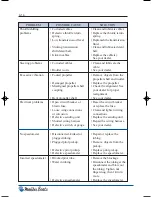
4-6
Rudder Stuffing Box
The rudder stuffing box has a grease nipple and should be checked and lubricated
annually. The rudder stuffing box is accessed through the rear center access panel directly
below the fuel tank. Use only a marine grade, waterproof grease.
Shaft Packing
Located in the bilge, under the rear center access panel, is the shaft packing. The shaft
packing is a seal where the prop shaft goes through the hull of the boat. This seal should
be checked and tightened periodically. Please note that it is normal for a small amount of
leakage to occur from this seal. It should leak at the rate of about one drop every ten
seconds.
Prop Shaft/Engine Alignment
As per Indmar’s recommended routine service maintenance, it is necessary to regularly
evaluate the prop shaft coupler bolts that attach the prop shaft to the engine. See Indmar
Owner’s Manual for proper prop shaft alignment. If the prop shaft bolts loosen
prematurely, major damage to your boat structure and driveline could result. It is
recommended that only a trained service technician perform this maintenance due to the
complications that can arise from an improperly balanced prop shaft engine alignment.
Damaged caused from loosened coupler bolts and improper
engine alignment is not covered under your Malibu Boats
warranty, and should be part of the owner’s service
responsibilities to ensure system is correct. See Malibu Boats
and Indmar Owner’s Manuals for appropriate timelines for
evaluation or checkup.
Fuel System
Fuel Filter
Your boat is equipped with a 1/2" in-line fuel filter
located 6 to 12 inches from the fuel tank. The filter
removes debris from the fuel being sent to the engine.
The filter should be changed after each season of boat
use. Often, fuel from lake Marinas will have a
considerable amount of debris and can eventually cause
your engine to run erratically. See your local Malibu
Dealer for servicing.
Hoses
Fuel lines, vent hoses, and drain hoses should be
checked frequently for leaks. If this is occurring around
the fitting, tightening of the hose clamps may be all t
hat is necessary. However, if the leak continues, replace the hose immediately to prevent
a build-up of fluids or gases. Surface cracking on hoses indicates wear, and replacement
is recommended. Use fuel system parts certified for marine use only. Do not substitute
with automotive parts.
Figure 4-2. In-Line Fuel Filter
Chapter 4 doc.qxd 8/17/04 3:10 PM Page 6
















































